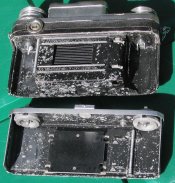Grytpype
Member
Recently I bought a "spares" Kiev 3a body on that auction site. I've seen a lot of fungus in my time, but this camera is the most disgusting I have ever seen by far! I could see straight away that fungus was all over the viewfinder optics and the prism (which is also broken or separating), but after I took the back off I could hardly put it back quickly enough - growths of mould all over the interior. The camera is currently banished from the house and in a utility room (in the sort of damp conditions that probably started the problem). As it stands I'd be afraid to strip the thing because of all the spores I'd be spreading, so the plan is to try and kill the fungus first.
I recently started a thread on this forum asking how I could kill possible fungus in a lens case, and fumigation with thymol crystals looked like a good prospect. I've made up a sort of fumigation chamber using an airtight plastic cake-box, with a car side-light bulb and UPS-type battery to provide a heat source to sublimate the thymol. I am aiming to give this a trial on the Kiev.
From web searches on thymol it seems that although it used to be considered THE thing for dealing with mould on books and documents, there now seems to be a lot of doubt among archivists as to its effectiveness. So the problem is how to determine after the thymol treatment whether the fungus is alive or defunct. I'm thinking in terms of scraping a bit of fungus on to a microscope slide and adding some sort of nutrient to see if the fungus grows. Obviously I would try this both before and after so I could contrast the result.
Does anyone know whether this could work, and what I could use to feed the fungus? Would any growth, even with nutrient, be so slow as to be undetectable within a realistic time-scale? Is there an easier, or quicker, way of testing for signs of life?
Thanks,
Steve.
I recently started a thread on this forum asking how I could kill possible fungus in a lens case, and fumigation with thymol crystals looked like a good prospect. I've made up a sort of fumigation chamber using an airtight plastic cake-box, with a car side-light bulb and UPS-type battery to provide a heat source to sublimate the thymol. I am aiming to give this a trial on the Kiev.
From web searches on thymol it seems that although it used to be considered THE thing for dealing with mould on books and documents, there now seems to be a lot of doubt among archivists as to its effectiveness. So the problem is how to determine after the thymol treatment whether the fungus is alive or defunct. I'm thinking in terms of scraping a bit of fungus on to a microscope slide and adding some sort of nutrient to see if the fungus grows. Obviously I would try this both before and after so I could contrast the result.
Does anyone know whether this could work, and what I could use to feed the fungus? Would any growth, even with nutrient, be so slow as to be undetectable within a realistic time-scale? Is there an easier, or quicker, way of testing for signs of life?
Thanks,
Steve.






 Remember fungus loves dampness and the dark. Hope this helps.
Remember fungus loves dampness and the dark. Hope this helps.